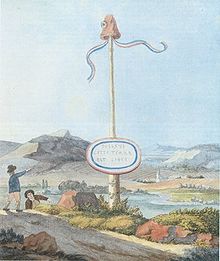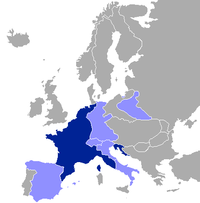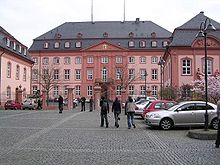- Republic of Mainz
-
Republic of Mainz
Rheinisch-Deutscher Freistaat
Mainzer Republik
République de MayenceClient of the First French Empire ← 
March – July 1793  →
→Capital Mainz Government Republic Historical era French Revolutionary Wars - Established 18 March 1793 - Disestablished 22 July 1793  Liberty pole at the French border at the Moselle. Similar poles were used also in the Republic of Mainz. The table reads "Passants, cette terre est libre" which translates to "Traveler, this land is free". Watercolour by Goethe.
Liberty pole at the French border at the Moselle. Similar poles were used also in the Republic of Mainz. The table reads "Passants, cette terre est libre" which translates to "Traveler, this land is free". Watercolour by Goethe.
The Republic of Mainz was the first democratic state on the current German territory[1] and was centered in Mainz. A product of the French Revolutionary Wars, it lasted from March to July 1793.
Contents
Context
During the First Coalition against France, the Prussian and Austrian troops that had invaded France retreated after the Battle of Valmy, allowing the French revolutionary army to counterattack. The troops of General Custine entered the Palatinate in late September, and occupied Mainz on 21 October 1792. The ruler of Mainz, Elector and Archbishop Friedrich Karl Joseph von Erthal, had fled the city.
Jacobin club
On the next day, 20 citizens of Mainz founded a Jacobin club, the Gesellschaft der Freunde der Freiheit und Gleichheit (Society of the Friends of Liberty and Equality). Together with their filial clubs founded later in Speyer and Worms, they promoted the Enlightenment and the French revolutionary ideals of liberté, egalité, fraternité in Germany, aiming for a German republic to be established following the French model. Most of the founding members of the Jacobin club were professors and students of the University of Mainz, together with the university librarian, Georg Forster, some merchants and Mainz state officials. For some time the ecclesiastic Friedrich Georg Pape was president of the club and editor of the "Mainzer Nationalzeitung" (Mainz National Newspaper).
Founding
By order of the French National Convention, elections in the French-occupied territories west of the Rhine were held on 24 February 1793.[citation needed] 130 cities and towns sent their deputies to Mainz.[citation needed]
The first[citation needed] democratically elected parliament in Germany, called the Rheinisch-Deutscher Nationalkonvent (Rhenish-German National Convention), met initially on 17 March 1793, in the Deutschhaus building in Mainz (nowadays the seat of the Rhineland-Palatinate state parliament). The convention declared the represented territory (which extended to Bingen in the west and to Landau in the south) to be free and democratic, and disclaimed any ties to the empire. The convention's president, Andreas Joseph Hofmann, proclaimed the Rhenish-German Free State (Rheinisch-Deutscher Freistaat) from the balcony of the Deutschhaus. On 23 March 1793, it was decided to send delegates (among them Georg Forster and Adam Lux) to Paris to seek the accession of the Mainz republic to France. The French National Convention granted this request on 30 March.
End
Soon after, Prussian troops retook all the French-occupied territory except for the heavily fortified city of Mainz itself. After a long siege in which much of the city was destroyed, Prussian and Austrian troops conquered the city on 22 July 1793. The republic ended, and the Jacobins were persecuted until 1795, when Mainz came under French control again.
Notes
- ^ The shortlived republic is often ignored in identifying the "first German democracy", in favour of the Weimar Republic; e.g. "the failure of the first German democracy after the First World War (the Weimar Republic)..." (Peter J. Burnell, Democracy Assistance: international co-operation for democratization 2000:131), or Ch. 3. 'The First Attempt at Democracy, 1918-1933', in Michael Balfour, West Germany: a contemporary history, 1982:60
Further reading
- Blanning, T. C. W. (1983). The French Revolution in Germany. Occupation and Resistance in the Rhineland 1792–1802. Oxford: Clarendon Press. ISBN 0198225644.
- Blanning, T. C. W. (1974). Reform and Revolution in Mainz 1743–1803. London: Cambridge University Press. ISBN 0521204186.
- Störkel, Arno (1994). The Defenders of Mayence in 1792: A Portrait of a Small European Army at the Outbreak of the French Revolutionary Wars. Canberra: The University of New South Wales.
Client states of the French Revolutionary and Napoleonic Wars (1792–1815) French client
republics
Europe at the height of Napoleon's Empire Other
Napoleonic
creations- Etruria
- Lucca and Piombino
- Kingdom of Italy
- Naples
Categories:- Former republics
- Former countries in Europe
- Client states of the Napoleonic Wars
- States and territories established in 1793
- States and territories disestablished in 1793
- 1793 disestablishments
- History of Rhineland-Palatinate
- History of Mainz
Wikimedia Foundation. 2010.

